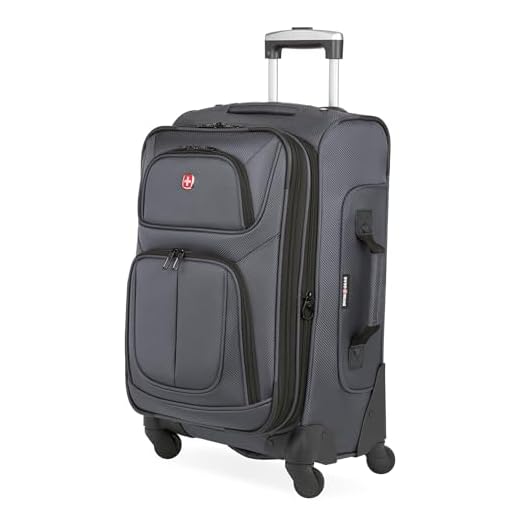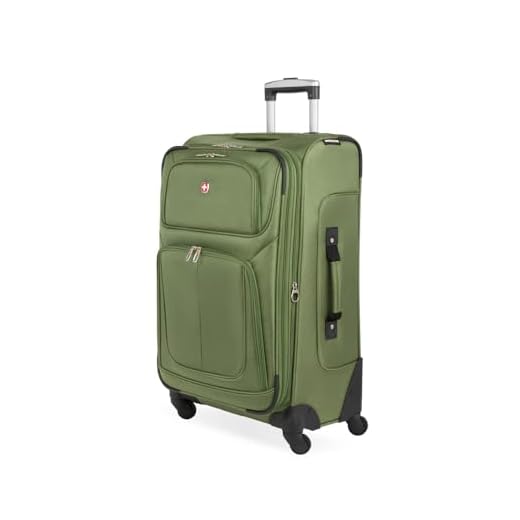







Prioritize weight limits and size restrictions specific to your airline. Adhering to these guidelines ensures your bags won’t face complications at check-in. Always check the airline’s website for the latest updates on allowable measurements.
The initial step involves presenting identification and your travel documents simultaneously to the agent. This provides a seamless experience and minimizes the chances of delays.
Once your belongings are on the scale, the agent will tag them, which includes scanning the barcodes linked to your flight information. It’s vital to confirm that the destination on the tag matches your travel plans to prevent misrouting.
Security screenings follow tagging, where bags pass through X-ray machines. Be mindful of packing prohibited items that could prompt additional checks. Familiarize yourself with restrictions on liquids and sharp objects to speed up this part of the process.
Finally, keep your boarding pass on hand for retrieval at your destination. Understanding these steps not only enhances your travel experience but also minimizes stress during busy travel periods.
Methods Utilized in Baggage Verification
Before boarding, items undergo a detailed examination. Each piece is weighed and measured to ensure compliance with airline specifications. Pay attention to the allowed dimensions, as exceeding these limits can lead to additional fees or refusal of transport.
The next phase involves security scrutiny. Advanced scanners detect prohibited items and potential threats. Travelers should ensure not to carry restricted goods, as they’ll trigger alarms and slow down the screening process. Always have essential documents ready to facilitate checks.
Labeling is another key aspect. Identifying tags must include the passenger’s name, destination, and contact information. This ensures proper routing and reunification in case of misplacement. Investing in durable tags that withstand wear can enhance traceability.
Post-examination, bags are typically sorted into designated areas based on their final destination. Efficiency in this part is critical, as it directly affects transmission to connecting flights or secure storage. Understanding the airport layout can aid in anticipating potential delays.
Lastly, tracking is implemented. Major airlines provide tracking options, allowing passengers to monitor their belongings from departure to arrival. Utilize this feature to stay informed about your item’s status throughout the transport process.
Understanding Baggage Weight Limitations
Limit your bag’s weight to avoid fees and ensure smooth travel. Airlines typically impose strict weight caps, commonly ranging from 15 to 23 kilograms (33 to 50 pounds) for checked items. Carry-ons often have lower limits, frequently around 7 to 10 kilograms (15 to 22 pounds).
Before packing, check the specific restrictions of your airline. Most carriers provide detailed guidelines on their websites, outlining dimensions and weight for both checked and cabin items. This information can help prevent surprises at the airport.
Use a reliable scale to weigh your baggage at home. Many travelers underestimate the weight of their belongings. Distributing items evenly can help you stay within limits and avoid excess charges.
Consider the following tips:
- Wear heavier clothing and shoes on board to save space and weight.
- Choose lightweight luggage to maximize capacity for your belongings.
- Utilize packing cubes to organize and minimize the volume of items.
- Review travel essentials and eliminate non-necessary items.
Familiarize yourself with potential excess baggage fees. Charges can vary significantly, sometimes costing upwards of $100 for additional weight. Knowing the fees can inform your packing decisions and budget.
Remember, overweight limitations differ depending on the fare class. Business and first-class travelers may enjoy higher allowances, so confirm your class benefits ahead of travel.
Be prepared for random checks at the airport. If your bag exceeds the weight, you may need to redistribute items. Be ready to adjust the load to comply with regulations.
Step-by-Step Procedure of Luggage Drop-off
Proceed directly to the designated check-in area once you arrive at the airport. Begin by locating the appropriate airline’s counter or self-service kiosk. If you’re using a kiosk, follow the on-screen instructions to enter your flight information and print your bag tags.
Attach the printed tags securely to your baggage. Ensure they are visible and not covered by any straps or materials. Next, place your items on the designated conveyor belt or directly at the counter where an airline representative will be present.
| Action | Description |
|---|---|
| Locate Check-in Area | Find your airline’s counter or kiosk. |
| Input Flight Details | Use the kiosk or representative to enter your flight info. |
| Tag Your Bags | Print and securely attach tags to each piece. |
| Submit Baggage | Place items on the conveyor or hand to the agent. |
A representative will weigh and scan your items, confirming they meet the airline’s standards. Keep your boarding pass and any claim checks provided, as they are essential for retrieving your items at your destination.
For those looking for quality outdoor gear, check out the best patio umbrella company. For aquarium enthusiasts, visit the best aquarium in ohio.
Security Screening Measures for Checked Baggage
Travelers should be aware that stringent security protocols are implemented for checked items to ensure safety. Each piece is subjected to advanced x-ray technology, enabling security personnel to identify potential threats without opening the bag.
Screening Techniques
Utilization of computed tomography (CT) scanners enhances the ability to detect concealed items. These machines create three-dimensional images, providing a more detailed view compared to traditional x-ray systems. This sophistication allows for quicker assessments, reducing wait times.
Additional Protocols
Once an anomaly is detected, a physical inspection may follow. Trained security agents will carefully inspect the contents of the baggage, often using specialized tools. Random checks are also a common procedure, which enhances the unpredictability and thus the overall effectiveness of security measures.
Furthermore, certain items may trigger alerts when scanned. Passengers transporting these goods are advised to declare them at the outset, facilitating a smoother inspection process.
Compliance with guidelines such as those set by international aviation authorities can expedite the screening experience. Being aware of prohibited items ahead of time minimizes the odds of delays.
Handling Lost or Damaged Baggage Claims
Submit your claim as soon as you realize your property is missing or has been damaged. Most airlines provide online forms for reporting issues, which can expedite the process. Be prepared with your ticket information, baggage claim tags, and a detailed description of the lost or damaged items.
Document everything thoroughly. Take photos of any damage and keep copies of receipts for valuable items, as this will strengthen your case. Ensure you get a reference number for your claim, as this will help you track its status.
Be aware of the airline’s specific policies regarding compensation; different carriers have varied limits and procedures. Many also require claims to be filed within a certain timeframe–often within 24 hours for damage and up to 21 days for lost items.
Stay persistent in follow-ups. If you’re not receiving responses, don’t hesitate to reach out to customer service, either via phone or social media. Sometimes, a more assertive approach can yield quicker resolutions.
Consider your options if you feel the airline isn’t adequately addressing your situation. Filing a complaint with a regulatory agency or seeking legal advice could be necessary steps. Additionally, having travel insurance can provide extra support in case of broader issues.
Proper preparation can help avoid common pitfalls. For instance, traveling with a best backpack black friday deals allows for keeping essential items on hand, minimizing frustration if mishaps occur.
FAQ:
What steps are involved in the luggage checking process at the airport?
The luggage checking process at the airport typically involves several steps. First, passengers arrive at the check-in counter where they present their identification and flight details. The airline staff then weighs the luggage and attaches a baggage tag to each piece, which includes a barcode containing important information about the passenger and their destination. After this, the luggage is placed on a conveyor belt and transported to a secure area for screening. Here, it goes through an X-ray machine for security checks to ensure there are no prohibited items. Once cleared, the bags are sorted and transferred to the airplane. Throughout this process, the luggage is tracked using the barcode system, making it easier to locate any missing bags. This ensures that the luggage reaches its destination along with the passenger.
How do airlines ensure the security of checked luggage?
Airlines take several measures to ensure the security of checked luggage. The first line of defense is the screening process, where every piece of luggage goes through X-ray machines operated by security personnel. These machines detect any suspicious items that could pose a threat. In addition to X-ray technology, some airports use advanced imaging systems and even canine units trained to sniff out explosives. Airlines also implement strict protocols for handling luggage, which includes limiting access to secured areas and using unique identification tags for tracking. Furthermore, regular audits and security assessments are conducted to enhance measures and adapt to new threats. The combination of technology, trained personnel, and rigorous procedures helps maintain high-security standards for all checked luggage.
What should passengers know about the weight and size restrictions for checked luggage?
Passengers should be aware that each airline has specific weight and size restrictions for checked luggage, which can vary significantly. Generally, most airlines allow checked bags to weigh between 50 to 70 pounds, and sizes typically must not exceed 62 linear inches (length + width + height). It’s important for travelers to check their airline’s policy before packing, as excess weight or oversized bags may incur additional fees. Additionally, personal items and carry-ons have their own guidelines that passengers need to follow. Being informed about these constraints can help avoid surprises and ensure a smoother check-in process. Some airlines also offer tools on their websites to help passengers measure and calculate their luggage dimensions before arriving at the airport.








